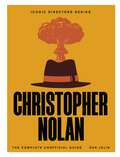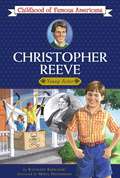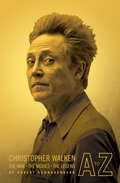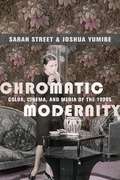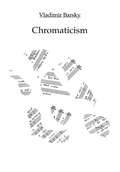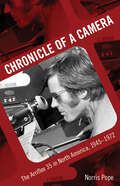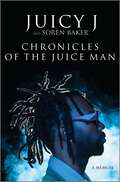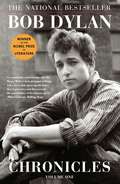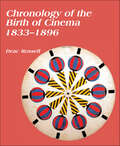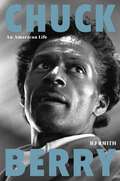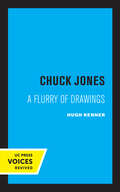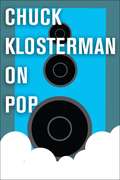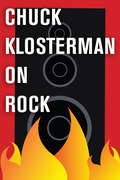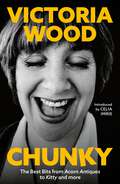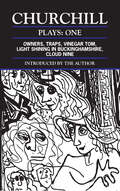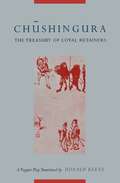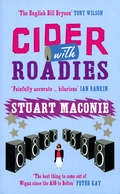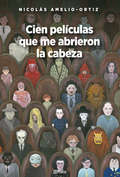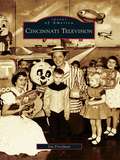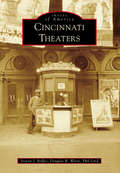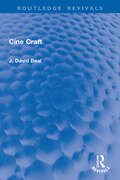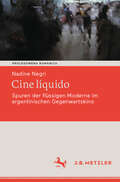- Table View
- List View
Christopher Nolan (Iconic Directors)
by Dan JolinFew filmmakers have made such a seismic impact on Hollywood during the past two decades as Christopher Nolan. Whether mind-twisting crime thrillers or vast sci-fi epics, his films are consistently huge crowd pleasers, despite his bold and complex visions never being compromised.Featuring fresh insights from a writer who has witnessed Nolan at work first-hand on several of his films, this is the definitive guide to the most significant British director since Hitchcock. From Memento to The Dark Knight Trilogy to Inception to Oppenheimer, it takes you on a cinematic odyssey that is truly like no other.
Christopher Reeve
by Kathleen V. Kudlinski Meryl HendersonChildhood of Famous Americans One of the most popular series ever published for young Americans, these classics have been praised alike by parents, teachers, and librarians. With these lively, inspiring, fictionalized biographies -- easily read by children of eight and up -- today's youngster is swept right into history.
Christopher Walken A to Z
by Robert SchnakenbergThe Complete Guide To All Things Walken He's been a dancer, a baker, a lion tamer, an award-winning actor, and a Hollywood legend. But Christopher Walken has never been the subject of a comprehensive biographical reference--until now. Here at last is a complete A-to-Z guide to this one-of-a-kind performer, featuring entries on everything from the Actors Studio (the legendary theatrical workshop where Walken spent eleven years as a janitor) to Zombie Movies (one of Walken's favorite film genres). Along the way, readers will discover: * Acting secrets and behind-the-scenes trivia from each of Walken's 100+ films--everything from Annie Hall to Hairspray and beyond. * Recipes and kitchen tips from "Chef Walken"--including a look at his short-lived TV show, Cooking with Chris. * Walken's music videos for Madonna, Duran Duran, and Fatboy Slim. * The secrets of maintaining his extraordinary hair. * Observations and reminiscences from Steven Spielberg, Quentin Tarantino, Tim Burton, Woody Allen, Dennis Hopper, and countless others. Plus more bizarre B movies and Saturday Night Live appearances than you can shake a cowbell at! Complete with fascinating trivia and dozens of photographs, Christopher Walken A to Z offers the definitive look at a pop culture phenomenon.
Chromatic Modernity: Color, Cinema, and Media of the 1920s (Film and Culture Series)
by Joshua Yumibe Sarah StreetThe era of silent film, long seen as black and white, has been revealed in recent scholarship as bursting with color. Yet the 1920s remain thought of as a transitional decade between early cinema and the rise of Technicolor—despite the fact that new color technologies used in film, advertising, fashion, and industry reshaped cinema and consumer culture. In Chromatic Modernity, Sarah Street and Joshua Yumibe provide a revelatory history of how the use of color in film during the 1920s played a key role in creating a chromatically vibrant culture.Focusing on the final decade of silent film, Street and Yumibe portray the 1920s as a pivotal and profoundly chromatic period of cosmopolitan exchange, collaboration, and experimentation in and around cinema. Chromatic Modernity explores contemporary debates over color’s artistic, scientific, philosophical, and educational significance. It examines a wide range of European and American films, including Opus 1 (1921), L’Inhumaine (1923), Die Nibelungen (1924), The Phantom of the Opera (1925), The Lodger (1927), Napoléon (1927), and Dracula (1932). A comprehensive, comparative study that situates film among developments in art, color science, and industry, Chromatic Modernity reveals the role of color cinema in forging new ways of looking at and experiencing the modern world.
Chromaticism
by Vladimir BarskyFirst Published in 1996. Routledge is an imprint of Taylor & Francis, an informa company.
Chronicle of a Camera: The Arriflex 35 in North America, 1945–1972
by Norris PopeThis volume provides a history of the most consequential 35mm motion picture camera introduced in North America in the quarter century following the Second World War: the Arriflex 35. It traces the North American history of this camera from 1945 through 1972—when the first lightweight, self-blimped 35mm cameras became available. Chronicle of a Camera emphasizes theatrical film production, documenting the Arriflex's increasingly important role in expanding the range of production choices, styles, and even content of American motion pictures in this period. The book's exploration culminates most strikingly in examples found in feature films dating from the 1960s and early 1970s, including a number of films associated with what came to be known as the “Hollywood New Wave.” The author shows that the Arriflex prompted important innovation in three key areas: it greatly facilitated and encouraged location shooting; it gave cinematographers new options for intensifying visual style and content; and it stimulated low-budget and independent production. Films in which the Arriflex played an absolutely central role include Bullitt, The French Connection, and, most significantly, Easy Rider. Using an Arriflex for car-mounted shots, hand-held shots, and zoom-lens shots led to greater cinematic realism and personal expression.
Chronicles of the Juice Man: A Memoir
by Soren Baker Juicy JA memoir by the Oscar-winning, platinum-selling rapper and producer for fans of Rick Ross&’s Hurricanes and The Autobiography of Gucci ManeThe hustle still continues for hip-hop OG Juicy J as he shares his invaluable story as an unwavering force in the music industry. Jordan Houston&’s rise to stardom was never easy. He began his journey on the streets of Memphis in the &’80s, always inspired by music and with big dreams of becoming a superstar rapper. Jordan stuck to his plan with determination, on a never-ending grind to greatness. From a young, poor, ambitious kid to an Academy Award–winning and Grammy-nominated recording artist and entrepreneur, the Juice Man offers his wisdom as one of the most influential tastemakers in the game.A raw, intentional portrait of artistry and a never-before-seen look into the making of a respected musical veteran, Chronicles of the Juice Man is an essential read for creatives everywhere.
Chronicles: Volume One
by Bob DylanWINNER OF THE NOBEL PRIZE IN LITERATURE The celebrated first memoir from arguably the most influential singer-songwriter in the country, Bob Dylan."I'd come from a long ways off and had started a long ways down. But now destiny was about to manifest itself. I felt like it was looking right at me and nobody else." So writes Bob Dylan in Chronicles: Volume One, his remarkable book exploring critical junctures in his life and career. Through Dylan's eyes and open mind, we see Greenwich Village, circa 1961, when he first arrives in Manhattan. Dylan's New York is a magical city of possibilities--smoky, nightlong parties; literary awakenings; transient loves and unbreakable friendships. Elegiac observations are punctuated by jabs of memories, penetrating and tough. With the book's side trips to New Orleans, Woodstock, Minnesota, and points west, Chronicles: Volume One is an intimate and intensely personal recollection of extraordinary times. By turns revealing, poetical, passionate, and witty, Chronicles: Volume One is a mesmerizing window on Bob Dylan's thoughts and influences. Dylan's voice is distinctively American: generous of spirit, engaged, fanciful, and rhythmic. Utilizing his unparalleled gifts of storytelling and the exquisite expressiveness that are the hallmarks of his music, Bob Dylan turns Chronicles: Volume One into a poignant reflection on life, and the people and places that helped shape the man and the art.
Chronology of the Birth of Cinema, 1833–1896
by Deac RossellWritten from an international perspective, this account of the origins of the cinema begins in 1833 with the introduction of optical toys for reproducing movement and ends with a thorough examination of the first full year of projected moving pictures in 1896. Comprehensive and verifiable, with citations that support each individual entry, the book examines the events that culminated in the establishment of the moving picture world that was the dominant visual medium of the last century. Drawing on a range of international sources, this chronology is a readable, vivid account that corrects many longstanding errors in the story of moving pictures while at the same time recording the astounding diversity of ideas, apparatus, personalities, and exhibitions that turned a passing novelty into a major industry. Populated by dreamers, inventors, scientists, and entrepreneurs with widely different skills, interests, and backgrounds, the many origins of the cinema are all recorded here in a rich tapestry that has been woven with attention to the detailed shape and placement of each individual thread. The result is a fully- indexed reference that reflects the state of modern scholarship and should be useful over the long term as both a reference to the period of early cinema and as a starting point for further research.
Chuck Berry: An American Life
by RJ SmithThe definitive biography of Chuck Berry, legendary performer and inventor of rock and roll Best known as the groundbreaking artist behind classics like &“Johnny B. Goode,&” &“Maybellene,&” &“You Never Can Tell&” and &“Roll Over Beethoven,&” Chuck Berry was a man of wild contradictions, whose motives and motivations were often shrouded in mystery. After all, how did a teenage delinquent come to write so many songs that transformed American culture? And, once he achieved fame and recognition, why did he put his career in danger with a lifetime&’s worth of reckless personal behavior? Throughout his life, Berry refused to shed light on either the mastery or the missteps, leaving the complexity that encapsulated his life and underscored his music largely unexplored—until now. In Chuck Berry, biographer RJ Smith crafts a comprehensive portrait of one of the great American entertainers, guitarists, and lyricists of the 20th century, bringing Chuck Berry to life in vivid detail. Based on interviews, archival research, legal documents, and a deep understanding of Berry&’s St. Louis (his birthplace, and the place where he died in March 2017), Smith sheds new light on a man few have ever really understood. By placing his life within the context of the American culture he made and eventually withdrew from, we understand how Berry became such a groundbreaking figure in music, erasing racial boundaries, crafting subtle political commentary, and paying a great price for his success. While celebrating his accomplishments, the book also does not shy away from troubling aspects of his public and private life, asking profound questions about how and why we separate the art from the artist. Berry declined to call himself an artist, shrugging that he was good at what he did. But the man's achievement was the rarest kind, the kind that had social and political resonance, the kind that made America want to get up and dance. At long last, Chuck Berry brings the man and the music together.
Chuck D Presents This Day in Rap and Hip-Hop History
by Chuck D Shepard FaireyA comprehensive, chronological survey of rap and hip hop from 1973 to the present by Chuck D, arguably the most influential rapper in the world.In the more than 40 years since the days of DJ Kool Herc and "Rapper's Delight," hip hop and rap have become a billion-dollar worldwide phenomenon. Yet there is no definitive history of the genre-until now.Based on Chuck's long-running show on Rapstation.com, this massive compendium details the most iconic moments and influential songs in the genre's recorded history, from Kurtis Blow's "Christmas Rappin'" to The Miseducation of Lauryn Hill to Kendrick Lamar's ground-breaking verse on "Control." Also included are key events in hip hop history, from Grandmaster Flash's first scratch through Tupac's holographic appearance at Coachella.Throughout, Chuck offers his insider's perspective on the chart toppers and show stoppers as he lived it. Illustrating the pages are more than 100 portraits from the talented artists specializing in hip hop.
Chuck Jones: A Flurry of Drawings (Portraits of American Genius #3)
by Hugh KennerCreator of the mono-maniacal Wile E. Coyote and his elusive prey, the Road Runner, Chuck Jones has won three Academy Awards and been responsible for many classics of animation featuring Bugs Bunny, Daffy Duck, Porky Pig, and Elmer Fudd. Who better to do Chuck Jones than Hugh Kenner, master wordsmith and technophile, a man especially qualified to illuminate the form of literacy that Jones so wonderfully executes in the art of character animation? A Flurry of Drawings reveals in cartoon-like sequences the irrepressible humor and profound reflection that have shaped Chuck Jones's work. Unlike Walt Disney, Jones and his fellow animators at Warner Brothers were not interested in cartoons that mimicked reality. They pursued instead the reality of the imagination, the Toon world where believability is more important than realism and movement is the ultimate aesthetic arbiter. Kenner offers both a fascinating explanation of cartoon culture and a new understanding of art's relationship to technology, criticism, freedom, and imagination. This title is part of UC Press's Voices Revived program, which commemorates University of California Press's mission to seek out and cultivate the brightest minds and give them voice, reach, and impact. Drawing on a backlist dating to 1893, Voices Revived makes high-quality, peer-reviewed scholarship accessible once again using print-on-demand technology. This title was originally published in 1994.
Chuck Klosterman on Pop
by Chuck KlostermanFrom Sex, Drugs, and Cocoa Puffs; Chuck Klosterman IV; and Eating the Dinosaur, these essays are now available in this ebook collection for fans of Klosterman's writing on pop music.
Chuck Klosterman on Rock
by Chuck KlostermanFrom Fargo Rock City; Sex, Drugs, and Cocoa Puffs; Chuck Klosterman IV; and Eating the Dinosaur, these essays are now available in this ebook collection for fans of Klosterman's writing on rock music.
Chuck's Band (Green Light Readers Level 1)
by Peggy Perry AndersonChuck and his barnyard friends are having a jam session and beginning readers are invited for a toe-tapping, knee-slapping good time. But what is the matter with Fat Cat Pat? Does she want her own musical instrument too, or is something else making that cat blue? Readers will have fun finding out in this perfectly pitched story! Full of rhyme, repetition, and musical instruments galore.
Chunky: The Best Bits from Acorn Antiques to Kitty and more
by Victoria Wood'Absolutely perfect. All Christmas presents sorted. No notes.' Sarra ManningBabs (on telephone): Acorn Antiques, can I help you? Gainsborough's Blue Boy? Yes, I think we have it in mauve, I'll just check.Flips over blank bits of paper.Yes, we do; shall I pop it under the counter for you? Not at all, bye!Chunky contains the complete scripts of Wood's beloved wobbly-walled spoof soap opera Acorn Antiques, as well as the Kitty monologues: 'My name's Kitty. I've had a boob off and I can't stomach whelks so that's me for you.'It also features daytime television presenters Margery and Joan, Susie the waspish Continuity Announcer, and the unforgettable bus stop stories of Kelly-Marie Tunstall: 'I said I'll tell everyone what happened on Christmas Eve when you drank two pints of correcting fluid and sexually harassed me with an outsize party squeaker'.Published to mark the 70th anniversary of Victoria Wood's birth, this stunning revised edition of Chunky collects the very best of Wood's sketches, shows and more featuring:NEW introduction from Celia Imrie, star of many of Victoria Wood's showsAdditions and annotations from Wood's acclaimed official biographer, Jasper Rees.This is a true celebration of an inimitable and greatly missed comedic genius.'I was very proud to be part of her gang.' Celia Imrie'There was none like her before and there's been none like her since - she was unique.' Dawn French'She is on a par with Alan Bennett.' Clive James
Churchill: Plays One
by Caryl ChurchillThe plays in this volume represent the best of Churchill's writing up to and including her emergence onto the international theatre scene with "Cloud Nine." The volume also contains a new introduction by the author as well as short prefaces to each play.
Chushingura: A Puppet Play (Translations from Asian Classics)
by Donald KeeneChushingura (The Treasury of Loyal Retainers), also known as the story of the Forty-Six (or Forty-Seven) Ronin, is the most famous and perenially popular of all Japanese dramas. Written around 1748 as a puppet play, it is now better know in Kabuki performances. In the twentieth century, cinema and television versions have been equally successful. Donald Keene here presents a complete translation of the original text, with notes and an introduction that increase the reader's comprehension and enjoyment of the play. <p><p>The introduction also elucidates the idea of loyalty. This traditional virtue, as exemplified in Chushingura, has never completely lost its hold on audiences, in spite of twentieth-century changes in Japanese society and moral ideas. Moreover, as Professor Keene points out, the excitement, color and violence expressed in the play may be considered the counterpoint to the austere restraint and understatement which are more commonly thought to be "traditionally" Japanese.
Cider With Roadies
by Stuart MaconieCider with Roadies is the true story of a boy's obsessive relationship with pop. A life lived through music from Stuart's audience with the Beatles (aged 3); his confessions as a pubescent prog rocker; a youthful gymnastic dalliance with northern soul; the radical effects of punk on his politics, homework and trouser dimensions; playing in crap bands and failing to impress girls; writing for the NME by accident; living the sex, drugs (chiefly lager in a plastic glass) and rock and roll lifestyle; discovering the tawdry truth behind the glamour and knowing when to ditch it all for what really matters.From Stuart's four minutes in a leisure centre with MC Hammer to four days in a small van with Napalm Death it's a life-affirming journey through the land where ordinary life and pop come together to make music.
Cien películas que me abrieron la cabeza
by Nicolás Amelio OrtizCien películas que me abrieron la cabeza es el viaje personal al que nos invita Nicolás para compartir su intenso amor por el cine. Una experiencia vital que empezó en la adolescencia, cuando vio Vértigo de Hitchcock por primera vez, y que lo acompaña desde entonces. Lejos de todo canon, este libro no pretende ser la selección de las películas que tenés que ver antes de morir; ni la lista de las que te recomiendan una y otra vez los profesores de cine. Son simplemente cien que a Nico le abrieron un mundo, y más de una vez le partieron la cabeza. En estas páginas concebidas desde la pasión y el desprejuicio total, conviven una de Ingmar Bergman y otra con Jim Carrey; la elegante obra de Luchino Visconti con la de su más sangriento compatriota Dario Argento; obras maestras del cine americano de los 70 con títulos de jóvenes autores que están destinados a romperla en los próximos años. Y alguna menospreciada y monstruosa belleza clase B que un crítico acaso demasiado "serio" no se atrevería a incluir en ninguna lista. No necesitás saber nada de cine para zambullirte en este libro: solo dejarte llevar e hipnotizar; descubrir y discutir. Y estar listo para emprender, como le pasó a Nicolás, un viaje alucinante para toda la vida.
Cigar Box Banjo
by Roddy Doyle Paul QuarringtonThis eclectic, funny, and moving book tracks a life lived in music and words. Paul Quarrington ruminates on the bands of his childhood; his restless youth, spent playing bass with the cult band Joe Hall and the Continental Drift; and his incarnation, in middle age, as rhythm guitarist and singer with the band Porkbelly Futures.Ranging through rock 'n' roll, the blues, folk, country and soul, he explores how songs are made, how they work, and why they affect us so deeply. This is also a book about friendship. In his imitably entertaining way, Quarrington recounts the adventures and vicissitudes he and his fellow band members share as they cope with everything from broken strings to broken marriages, making a last stab at that elusive thing called success.
Cincinnati Television (Images of America)
by Jim FriedmanCincinnati has a distinguished television history. Beginning before WLW-T signed on the air in February 1948, its experimental station W8XCT broadcast from the 46th floor of the Carew Tower. WKRC-TV and WCPO-TV signed on in 1949, WCET in 1954, and WXIX-TV in 1968. Since then, television has become part of the family. Uncle Al, Skipper Ryle, Batty Hattie from Cincinnati, the Cool Ghoul, Peter Grant, Al Schottelkotte, Nick Clooney, Ruth Lyons, Paul Baby, Bob Braun, and Jerry Springer visited Cincinnati living rooms on television. Remember Midwestern Hayride, TV Dance Party, PM Magazine, Juvenile Court, Young People's Specials, Lilias, Dotty Mack, Bob Shreve, Mr. Hop, Bean's Clubhouse, The Last Prom, and Ira Joe? They are part of the collective Cincinnati history, part of the Cincinnati culture, and part of the Cincinnati family.
Cincinnati Theaters (Images of America)
by Douglas R. Weise Steven J. Rolfes Phil LindTheaters have always been the places where memories are made. There, on Saturday afternoons, children could escape the pressures of growing up to live for two hours in a fantasy world of daring heroes, dastardly villains, and dazzling magic. They were the places where awkward teenage boys could nervously, and often clumsily, put their arms around equally nervous girls. In years past, every neighborhood had its own local theater. Downtown was home to the great movie palaces, ornate portals to a world of motion picture thrills. For a unique experience, nothing could beat a hot summer night at the drive-in. Today, in the era of the corporate multiplex, the great movie palaces are just memories. Some neighborhood cinemas are now churches or venues for meetings, wedding receptions, and small concerts. Images of America: Cincinnati Theaters looks back at these marvelous old theaters and the days when they were in their prime.
Cine Craft (Routledge Revivals)
by J. David BealCine Craft (1974) is an ideal guide to the world of amateur film making, a treasure-house of authoritative information. It covers the equipment, both basic and advanced, and the planning needed for a successful production. It looks at indoor and outdoor shooting, composition, exposure, continuity and camera movement, editing and titling, and the methods and use of recorded sound. An intriguing chapter deals with the various forms of cine animation using puppets, cut-outs and cells.
Cine líquido: Spuren der flüssigen Moderne im argentinischen Gegenwartskino (Prolegomena Romanica. Beiträge zu den romanischen Kulturen und Literaturen)
by Nadine NegriMitte der 90er Jahre wendet sich in Argentinien eine neue Kinoströmung radikal von den bis dato gültigen, vom Hollywoodkino inspirierten und pathetischen Filmstandards ab. Die von der Kritik schnell unter dem Sammelbegriff „Nuevo Cine Argentino“ zusammengefassten Werke zeichnen sich jedoch neben minimalistischen Tendenzen und Parallelen zum italienischen Neorealismus und der französischen „Nouvelle Vague“ insbesondere durch ihre Heterogenität aus. Die vorliegende Studie versteht das „Nuevo Cine Argentino“ als Manifestation einer ganzheitlichen soziokulturellen und geistigen Transformation: Die Entstehung des neuen argentinischen Films fällt mit einer Verflüssigung (Zygmunt Bauman), einer umfassenden Dynamisierung, Dezentralisierung und Individualisierung der westlichen Gesellschaften um die Jahrtausendwende zusammen. Die Studie geht von der Hypothese aus, dass sich gerade in den Eigenschaften des Flüssigen – Flexibilität, Flüchtigkeit und Formlosigkeit – ein Schlüssel für die Beschreibung des „Nuevo Cine Argentino“ findet. Sowohl inhaltlich auch formell finden sich in den Filmen Spuren der flüssigen Moderne. Anhand von zahlreichen bekannten, aber auch weniger rezipierten Filmen der letzten 25 Jahre erarbeitet die Autorin Charakteristika eines „cine líquido“. Dieses wird präsentiert als ein instrumenteller Kinomodus, der für die Darstellung von sozialen Verflüssigungsprozessen genutzt werden kann.
